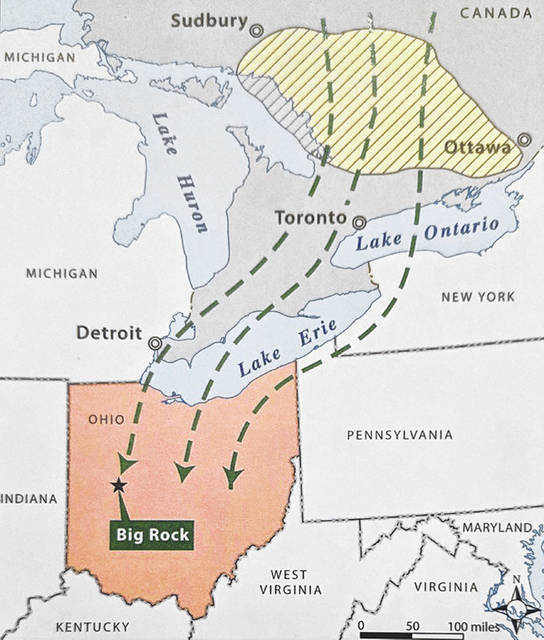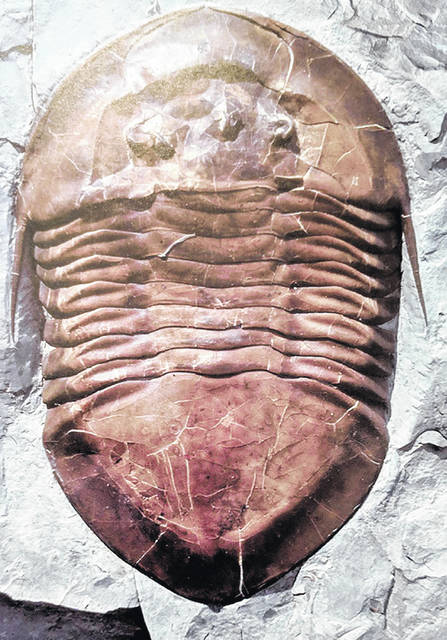


Editor’s note: in conjunction with the 200th celebration of the establishment of Shelby County, the Sidney Daily News will be publishing a year long series about the county’s history.
SIDNEY — It happened a very long time ago, some 4.6 billion years by count, according to the best scientific estimate. Swirling clouds of gas and particles of dust — material left over from the formation of the Sun — bashed together and contracted throughout the vastness of space and eventually formed a sphere called Earth. Originally composed of molten matter similar to lava erupting onto the island of Hawai’i at the present time, the surface cooled over the passage of hundreds of millions of years to the point a crust of solid rock existed, portions of which would ultimately be named Ohio.
This first chapter in the story of Shelby County — Precambrian time — covers 88 percent of the span of geologic history and ended 541 million years ago. Terrestrial vegetation had not yet evolved and the land was continually impacted by forces of wind, water, ice and gravity. Surface temperatures dropped, oceans filled in low-lying areas, river systems were established and an Earth-enveloping atmosphere formed. Life was found only in the saltwater seas, initially composed of colonies of algae and then later numerous categories of soft-bodied animals.
Precambrian rocks in the Buckeye State exist only at great depths, but information from deep wells indicate Ohio was physically affected by the formation of the Grenville Mountains, a north-south oriented chain of highlands that rivaled the appearances of the present day Rocky Mountains. Eventually these cloud-piercing heights, the foothills of which extended westward into Shelby County, were reduced to a gently rolling landscape of granite, a rock similar to many tombstones seen in Graceland Cemetery. When rising sea levels began to inundate this hard-rock surface the Precambrian history of Shelby County ended.
As the next phase of history opened — the Cambrian, a segment of geologic time that lasted for 56 million years and ended 485 million years ago — Ohio was positioned below the equator, some 60 degrees south of its present geographic location. Rivers flowing off the Grenville Mountains into the sea covering the Buckeye State deposited first sand and mud and later carbonate sediment that was gradually buried and compressed into sandstone, shale and limestone. These rock units, buried at depths ranging from 1,800 to 3,200 feet in Shelby County, are known respectively as the Mount Simon, Eau Claire and Knox Dolomite formations.
A rich and varied suite of life existed during this time, characterized by the appearance of marine organisms that armored themselves with a variety of hard body parts, an evolutionary innovation that created not only protection from predators but also a chance of being preserved as fossils. Paleontologists estimate that 60 percent of Cambrian life was composed of trilobites, a generally thumb sized, segmented ancestor to modern day crabs, spiders and insects that fed on worms, plankton and algae. The remaining 40 percent of life was composed largely of brachiopods (similar to lampshells), echinoderms (like starfish), gastropods (related to snails) and sponges.
The Ordovician Period — lasting for 41 million years and ending 444 million years ago — is often referenced as the occasion of the greatest ever submergence of North America, because a shallow sea covered the entirety of the region today known as the American Midwest, including the whole of Ohio. Trenton Limestone, the rock deposited at this time in Shelby County, is dark-gray to brown in color, quite fossiliferous and lies at depths greater than 1300 feet. The very first giant oil field discovered in North America was found in the 190-mile-long trend of Trenton Limestone that extends from Toledo to Indianapolis. Over 50 individual accumulations of oil and natural gas are named within this trend, four of which lie partially or entirely within the confines of Shelby County, named the Cynthian, Loramie and Minister oil fields and the St. Marys gas field.
Rock representing the Silurian Period in Shelby County carries a variety of formational names, the most common being Brassfield, Lockport and Salina. Exposures of 430 to 419 million year old Lockport and Salina Dolomite, a limestone-type of rock enriched with magnesium, occurs in Shelby County along the valley of the Great Miami River south of Port Jefferson to the Miami County line and in deeply eroded sections of the valleys of Turtle Creek and East Turtle Creek east and west of the community of Hardin. These exposures have been surface mined by at least five quarries that have operated in the county in recent decades. Silurian marine life was similar to that of Ordovician time. Onshore, the land was covered by blankets of mosses, a primitive form of vegetation with shallow roots. The green revolution of Earth was underway.
As this period of geologic time came to an end the surface rock terrain of Ohio, and Shelby County, had continued its snails-pace migration to the north, moving from 20 degrees south of the Equator to a position now some 10 to 15 degrees north of the Equator. This transformation in global geography was fueled by temperature and pressure forces lying deep within the subsurface, a process that continues to this day transferring fractured sections Earth’s crust in diverse directions of the compass at a speed rivaling the annual growth rate of the human fingernail.
The pages covering the next 416 million years of this history are blank, as rocks representative of this age gap have yet to be found in Shelby County — geologic history cannot be written in areas where rocks do not exist.
The shortest chapter in Shelby County geologic history began 2.6 million years ago when global temperatures declined and two-thirds of Ohio became embraced by four major invasions of ice, each estimated to have been at least one mile thick. The last retreated from Shelby County some 10,000 years ago, leaving a legacy of mineral-rich soil and a peculiarity which graces a section of East Sidney. Weighing 103 tons and composed of 1,250 cubic feet of garden-variety granite, Big Rock was quarried by glacial ice from bedrock in southeastern Canada, transported 600 miles south and west and unceremoniously deposited in Tawawa Park as the ice melted.
About the time the last of the great “Ice Age” glaciers retreated to the north, families of Paleo-Indians — the first generation of Shelby County populations — are believed to have entered the valley of the Great Miami River. After 4.6 billion years of Earth evolution molded by forces of mountain building, erosion, earthquakes, ocean advances and retreats and glaciation Shelby County was situated across the 40th degree North Latitude, its current location — and ready for the next significant stage of its history. The curtain was rising on the era of mankind.




